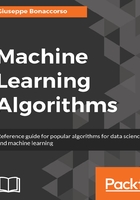
Summary
In this chapter, we introduced the concept of adaptive systems; they can learn from their experiences and modify their behavior in order to maximize the possibility of reaching a specific goal. Machine learning is the name given to a set of techniques that allow implementing adaptive algorithms to make predictions and to auto-organize input data according to their common features.
The three main learning strategies are supervised, unsupervised, and reinforcement. The first one assumes the presence of a teacher that provides a precise feedback on errors. The algorithm can hence compare its output with the right one and correct its parameters accordingly. In an unsupervised scenario, there are no external teachers, so everything is learned directly from the data. An algorithm will try to find out all features common to a group of elements to be able to associate new samples with the right cluster. Examples of the former type are provided by all the automatic classifications of objects into a specific category according to some known features, while common applications of unsupervised learning are the automatic groupings of items with a subsequent labeling or processing. The third kind of learning is similar to supervised, but it receives only an environmental feedback about the quality of its actions. It doesn't know exactly what is wrong or the magnitude of its error but receives generic information that helps it in deciding whether to continue to adopt a policy or to pick another one.
In the next chapter, we're going to discuss some fundamental elements of machine learning, with particular focus on the mathematical notation and the main definitions that we'll need in all the other chapters. We'll also discuss important statistical learning concepts and some theory about learnability and its limits.